
Wreckage from the USS Juneau (CL-52) was discovered on March 17, 2018, by the expedition crew of Research Vessel (R/V) Petrel, which is owned by Microsoft co-founder and philanthropist Paul G. Allen.
The Juneau was sunk by a Japanese torpedo during the Battle of Guadalcanal, ultimately killing 687 men aboard including all five Sullivan brothers.
The Atlanta-class light cruiser was found 4,200 meters below the surface, resting on the floor of the South Pacific off the coast of the Solomon Islands.
(Nearly 80 years after a wartime tragedy, a lost Navy ship has been found at the bottom of the ocean. The USS Juneau was part of the fleet that fought Japanese forces in the Pacific. But during the Battle of Guadalcanal in 1942, a Japanese torpedo struck the Juneau. The ship sank, sending hundreds of sailors, including five brothers, to watery graves. No one knew its location until St. Patrick’s Day, when a research vessel funded by Microsoft co-founder Paul Allen located the ship. Courtesy of Inside Edition and YouTube. Posted on Mar 20, 2018)
“We certainly didn’t plan to find the Juneau on St. Patrick’s Day. The variables of these searches are just too great,” said Robert Kraft, director of subsea operations for Mr. Allen.
“But finding the USS Juneau on Saint Patrick’s Day is an unexpected coincidence that allows us to pay final respects to the Sullivan brothers and all the service members who were lost 76 years ago.”

The R/V Petrel’s autonomous underwater vehicle (AUV) first identified the ship in its side scan sonar on March 17.
Upon analysis of the sonar data, the Petrel crew deployed its remotely operated underwater vehicle (ROV) on March 18 to verify the wreckage through its video feed.

“As the fifth commanding officer of USS The Sullivans (DDG 68), a ship named after five brothers, I am excited to hear that Paul Allen and his team were able to locate the light cruiser USS Juneau (CL 52) that sunk during the Battle of Guadalcanal,” said Vice Adm. Rich Brown, commander, Naval Surface Forces.
“The story of the USS Juneau crew and Sullivan brothers epitomize the service and sacrifice of our nation’s greatest generation.”
The USS Juneau had a short service history only being commissioned just under a year prior to it sinking.
During its fateful battle on November 13, 1942, a second torpedo hit on its port side creating a significant explosion that cut the ship in half and killed most of the men onboard, including all five Sullivan brothers.
Because the Juneau sank in 30 seconds and due to the risk of further Japanese attacks, the American task force did not stay to check for survivors.
(Learn More. Billionaire Microsoft co-founder Paul Allen has announced the discovery of yet another historic World War II vessel. Courtesy of Stars & Stripes. Posted on Mar 20, 2018)
Although approximately 115 of Juneau‘s crew reportedly survived the explosion, including possibly as many as two of the five Sullivan brothers, naval forces did not undertake rescue effort for several days and only 10 men were rescued from the water eight days after the sinking.
The Sullivan family of Waterloo, Iowa lost their sons George, Francis “Frank,” Joseph, Madison “Matt” and Albert despite the naval policy that prevented siblings from serving together.
The brothers refused to serve unless assigned to the same ship, so the policy was not enforced. According to naval historians, the brothers’ deaths became a rallying cry for the allied forces.
“I had the opportunity to visit The Sullivans earlier this month and I can tell you the fighting spirit of the Sullivan brothers – George, Frank, Joe, Matt and Al – lives on through the fantastic crew that mans the ship today,” said Brown.
“The crew embodies the ship’s motto, ‘We Stick Together’ each day.”
“My time on The Sullivans and the relationship I formed with the ship’s sponsor, Kelly, the granddaughter of Albert, are some of my most cherished memories.”
(Wreckage from the USS Juneau was discovered on March 17, 2018 by the expedition crew of Paul G. Allen’s Research Vessel (R/V) Petrel. The Juneau was sunk by a Japanese torpedo during the Battle of Guadalcanal, ultimately killing 687 men aboard including all five Sullivan brothers. The Atlanta-class light cruiser was found 4,200 meters deep, resting on the floor of the South Pacific off the coast of the Solomon Islands. Courtesy of Vulcan Inc.. Posted on Mar 19, 2018)
The USS Juneau was part of what some considered a suicide mission in the Battle of Friday the 13th, 1942.

A force of five American cruisers and eight destroyers had been assigned the mission to interdict a Japanese task group and prevent a second devastating battleship bombardment of Henderson Field and U.S. Marine positions on Guadalcanal.
Ultimately, the five Sullivan brothers and a total of 1,439 American Sailors would not survive the point-blank, vicious sea battle with two Japanese battleships, a light cruiser, and 11 destroyers.
By the time the battle was over, of the 13 U.S. ships engaged, two anti-aircraft cruisers (Atlanta (CL-51) and Juneau (CL-52)) and four destroyers (Cushing (DD-376), Laffey (DD-459), Barton (DD-599), and Monssen (DD-436)) would be sunk.
Two heavy cruisers (San Francisco and Portland (CA-33)) and two destroyers (Sterret (DD-407) and Aaron Ward (DD-483)) were seriously damaged.
Only the light cruiser Helena (CL-50) and destroyers O’Bannon (DD-450) and Fletcher (DD-445) survived with minimal damage or no casualties.

The Japanese lost two destroyers, but Hiei, one of their two battleships, was badly damaged and was sunk the next day by U.S. Navy and Marine aircraft, flying from Henderson Field and USS Enterprise (CV-6).
Most important, the Americans accomplished their mission in preventing a bombardment of Henderson Field, and helped prevent about 5,000 Japanese reinforcements from reaching the island, and sinking almost all the supplies and ammunition of the 2,000 who did.
In conjunction with yet another brutal battle during the night of November 14/15, this engagement turned the tide of the campaign for Guadalcanal in favor of the United States— but at great cost.
Allen-led expeditions have also resulted in the discovery of the USS Lexington (March 2018), USS Indianapolis (August 2017), USS Ward (November 2017), USS Astoria (February 2015), Japanese battleship Musashi (March 2015) and the Italian WWII destroyer Artigliere (March 2017).
His team was also responsible for retrieving the ship’s bell from the HMS Hood for presentation to the British Navy in honor of its heroic service.
Mr. Allen’s expedition team was permanently transferred to the newly acquired and retrofitted R/V Petrel in 2016 with a specific mission around research, exploration and survey of historic warships and other important artifacts.

The 250-foot R/V Petrel is fitted with state-of-the-art subsea equipment capable of diving to 6,000 meters (or three and a half miles).
Four decades after co-founding Microsoft, entrepreneur and philanthropist Paul G. Allen is still exploring the frontiers of technology and human knowledge, and acting to change the future.
















